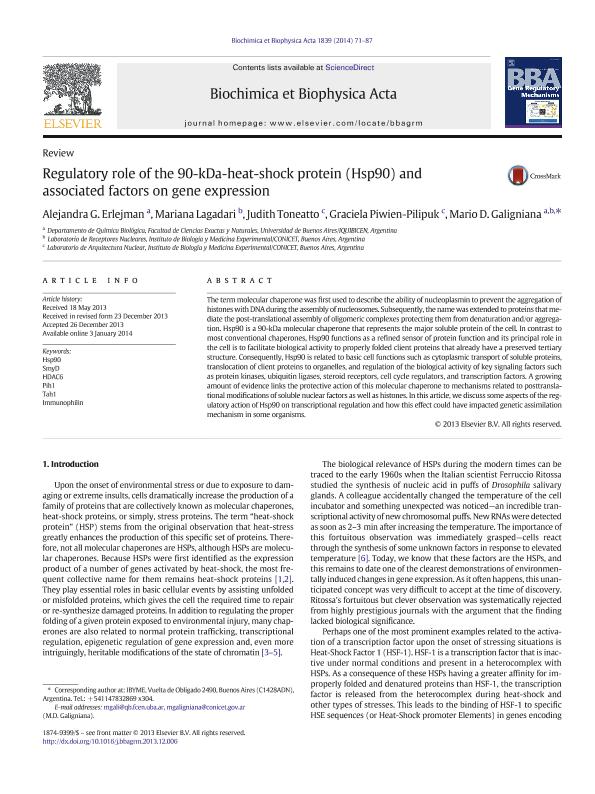Artículo
Regulatory role of the 90-kDa-heat-shock protein (Hsp90) and associated factors on gene expression
Erlejman, Alejandra Giselle ; Lagadari, Mariana
; Lagadari, Mariana ; Toneatto, Judith
; Toneatto, Judith ; Piwien Pilipuk, Graciela
; Piwien Pilipuk, Graciela ; Galigniana, Mario Daniel
; Galigniana, Mario Daniel
 ; Lagadari, Mariana
; Lagadari, Mariana ; Toneatto, Judith
; Toneatto, Judith ; Piwien Pilipuk, Graciela
; Piwien Pilipuk, Graciela ; Galigniana, Mario Daniel
; Galigniana, Mario Daniel
Fecha de publicación:
02/2014
Editorial:
Elsevier
Revista:
Biochimica And Biophysica Acta
ISSN:
0006-3002
Idioma:
Inglés
Tipo de recurso:
Artículo publicado
Clasificación temática:
Resumen
The term molecular chaperone was first used to describe the ability of nucleoplasmin to prevent the aggregation of histones with DNA during the assembly of nucleosomes. Subsequently, the name was extended to proteins that mediate the post-translational assembly of oligomeric complexes protecting them from denaturation and/or aggregation. Hsp90 is a 90-kDa molecular chaperone that represents the major soluble protein of the cell. In contrast to most conventional chaperones, Hsp90 functions as a refined sensor of protein function and its principal role in the cell is to facilitate biological activity to properly folded client proteins that already have a preserved tertiary structure. Consequently, Hsp90 is related to basic cell functions such as cytoplasmic transport of soluble proteins, translocation of client proteins to organelles, and regulation of the biological activity of key signaling factors such as protein kinases, ubiquitin ligases, steroid receptors, cell cycle regulators, and transcription factors. A growing amount of evidence links the protective action of this molecular chaperone to mechanisms related to posttranslational modifications of soluble nuclear factors as well as histones. In this article, we discuss some aspects of the regulatory action of Hsp90 on transcriptional regulation and how this effect could have impacted genetic assimilation mechanism in some organisms.
Palabras clave:
Hsp90
,
Smyd
,
Hdac6
,
Tha1
,
Immunophilin
Archivos asociados
Licencia
Identificadores
Colecciones
Articulos(IBYME)
Articulos de INST.DE BIOLOGIA Y MEDICINA EXPERIMENTAL (I)
Articulos de INST.DE BIOLOGIA Y MEDICINA EXPERIMENTAL (I)
Articulos(SEDE CENTRAL)
Articulos de SEDE CENTRAL
Articulos de SEDE CENTRAL
Citación
Erlejman, Alejandra Giselle; Lagadari, Mariana; Toneatto, Judith; Piwien Pilipuk, Graciela; Galigniana, Mario Daniel; Regulatory role of the 90-kDa-heat-shock protein (Hsp90) and associated factors on gene expression; Elsevier; Biochimica And Biophysica Acta; 1839; 2; 2-2014; 71-87
Compartir
Altmétricas



